Guide to learning Japanese on your own
Learning Japanese on your own may seem intimidating, but it’s not impossible. It is all about being consistent in your learning, coupled with hard work. If you find yourself lost and don’t know how to start your learning journey, follow our guide to kickstart your journey towards achieving your dreams of watching anime without English subtitles.
3 Japanese scripts
First off, master the basics by learning the 3 different Japanese scripts, namely hiragana, katakana and kanji.
Hiragana is the standard written form of Japanese that can be used on its own or alongside kanji to form words, phrases, and sentences. Beginners often start off with hiragana before incorporating kanji into their sentences.
Katakana, on the other hand, is used for foreign words, onomatopoeias, or simply for emphasis.
Lastly, kanji refers to logograms derived from the Chinese script. For instance, the Japanese word for “water” is written as “みず” (mizu) in hiragana, but you can also write mizu in its kanji form: 水. The pronunciation is the same.
1. Hiragana
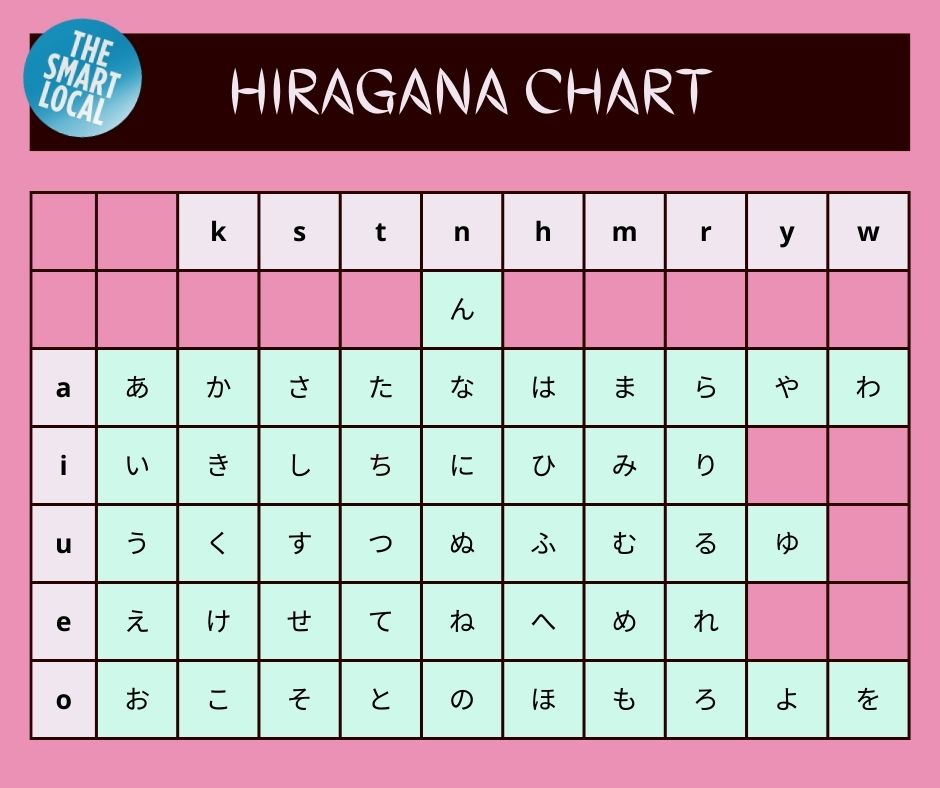
Image credit: Ng Yee Shyan
This may sound dry, but there’s just no way around it; when you start learning Japanese, memorising hiragana characters is a must. There are 5 vowels and 14 consonants in the Japanese language, and they can be combined to form a syllable. Do refer to the our hiragana chart to memorise the characters!
Japanese syllables can comprise purely vowels or “ん” (n), but it can also be made by combining a vowel and a consonant sound,
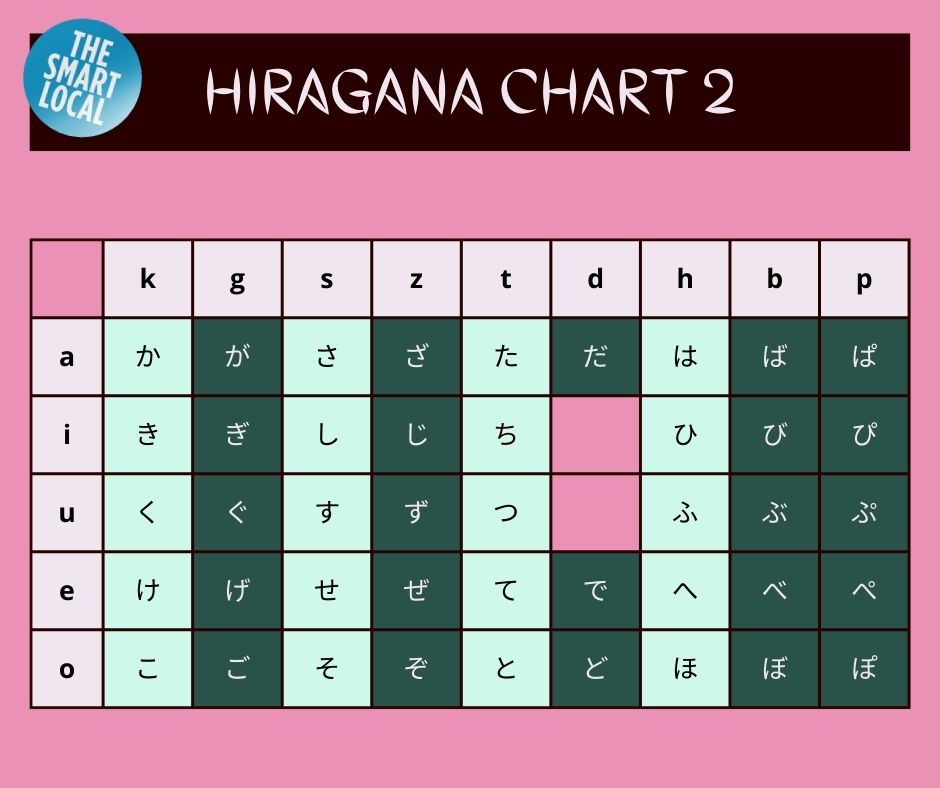 Image credit: Ng Yee Shyan
Image credit: Ng Yee Shyan
The first chart has 9 consonants along with the vowels while the second chart has the remaining 5 consonants. The remaining 5 consonants are actually derived from the previous set consonants with the addition of either a dakuten (゙) – two small lines – or a handakuten (゚) – a small circle – at the top right of the character.
For example, adding a dakuten (゙) to “か” (ka) will turn it into “が” (ga). Once you’ve memorised the first hiragana chart, the second chart will be a breeze.
The best way to memorise the characters is to use trace sheets for writing practice. Not only do these sheets teach you the correct stroke order, but they also help train your penmanship.
 Image adapted from: Tofugu
Image adapted from: Tofugu
If you are still struggling to commit the characters to memory, perhaps image-based mnemonics would help. You can visit Tofugu’s hiragana guide if you prefer learning via picture-association, rather than rote memorisation.
Another helpful way to memorise hiragana is to watch tutorial videos and follow along. This way, you can see how each character is written. The Japanese Calligrapher Takumi’s video is a good beginner’s tutorial and you can watch it here:
Video credit: Japanese Calligrapher Takumi
2. Katakana
 Image credit: Ng Yee Shyan
Image credit: Ng Yee Shyan
The process of learning katakana is very similar to learning hiragana, given that it is simply another set of characters to memorise. Do use our chart for easy reference and also practise writing the katakana characters by using trace sheets.

Image credit: Ng Yee Shyan
Similarly to hiragana, the second katakana chart consists of characters with slight change in pronunciation through the addition of a dakuten (゙) or a handakuten (゚). For example, adding a handakuten (゚) to “ハ” (ha) turns it into “パ” (pa).
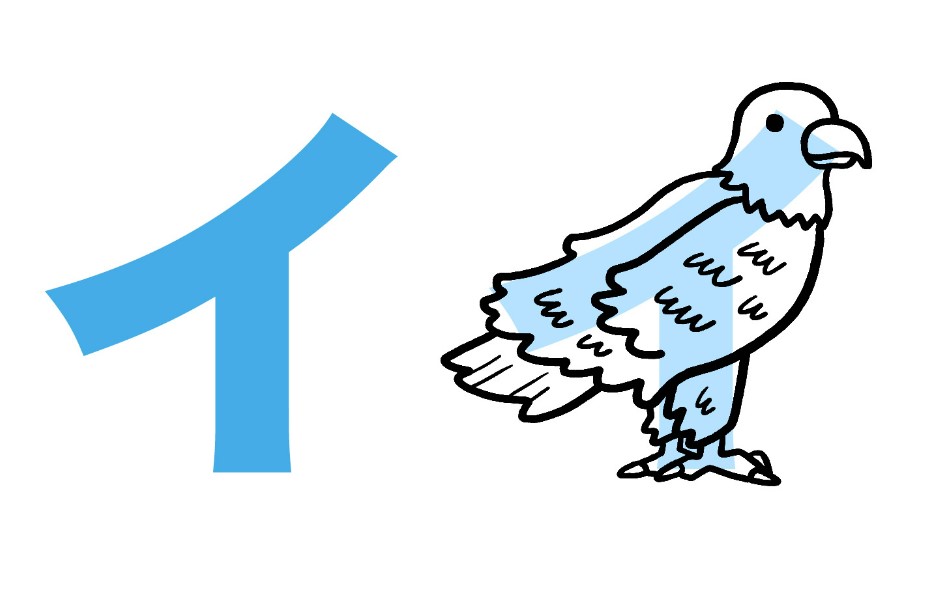
Image adapted from: Tofugu
Visual learners may benefit from using image-based mnemonics to pick up katakana – again, Tofugu is a great resource. Otherwise, you can learn how to write the katakana characters by watching video tutorials that guide you through each stroke. Check out this one by Japanese Calligrapher Takumi:
Video credit: Japanese Calligrapher Takumi
3. Kanji
 Image credit: Beheim
Image credit: Beheim
The last and easily the most difficult Japanese script is kanji, which has over 2,000 characters just for daily use.
To tackle the monster that is kanji, memorise its radicals and try and associate it with images or concepts. So what are radicals? Tofugu explains this very well, but here’s an example to tide you through:
 Image credit: Daoudi Aissa
Image credit: Daoudi Aissa
For example, the kanji for “risk” is 冒 (oka). It is made of 2 radicals, 日 (sun) and 目 (eye). To make the word easier to remember, try creating a story. For instance, it is a risk (冒) to look at the sun (日) with your eyes (目).
One of the best ways to memorise kanji is to use Anki, which has a database of kanji flashcards that you can revisit every day until you commit them to memory. Set how many new kanji you want to learn each day and Anki will give it to you accordingly, along with all the words you have learnt previously so you don’t forget them.
You can also use mobile apps such as Kanji Garden if you want to learn kanji on the go, or WaniKani if you wish to learn kanji with the help of mnemonics.
4. Pronunciation
Learning the basics of any language requires much more than mastering the written word; the spoken word is just as important, which brings us to pronunciation.
While memorising hiragana and katakana characters, it’s helpful to watch videos that teach you the respective writing scripts – hiragana and katakana – as you’ll be exposed to the correct pronunciation as well.
Vowels
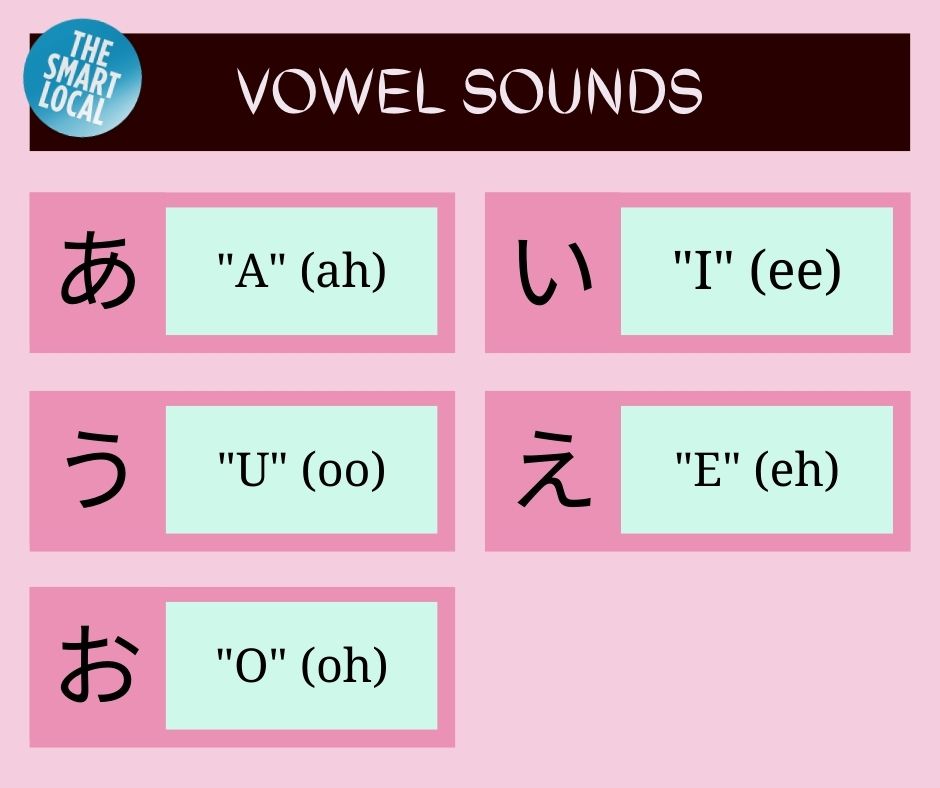
Image credit: Ng Yee Shyan
Japanese pronunciation may seem difficult to master at first glance, but after realising that it strictly follows the 5 vowel sounds, the only difficulty then lies in the embellishments: learning to combine and pronounce the consonant sounds and varying your pitch and tone for each word appropriately.
The 5 vowel sounds – a, i, u, e, and o – in Japanese remains pretty much the same no matter what, unlike in English, so that’s another plus.
Long vowel sounds in Japanese are represented by the addition of a vowel in hiragana or the addition of the ー symbol in katakana.
For example, “りょうこう” (ryoukou; good), as compared to “りょこう” (ryokou; travel) has an additional う, which prolongs the “ryou” sound when spoken. The long vowels in the words will be stressed, giving greater emphasis.
 Image credit: Ng Yee Shyan
Image credit: Ng Yee Shyan
For syllables that end with the vowel “い” (i), you can add a small “ゃ” (ya), “ゅ” (yu), or “ょ” (yo) to create a new sound similar to a contraction. So, combining “き” (ki) and “や” (ya) will give you ”きゃ” (kya), which sounds like “kiya” read really fast.
Be careful not to pronounce the “い” (i) as doing so may give you a completely different word with another meaning!
For example, pronouncing “じゅう” (jyuu; ten) as jiyuu (じゆう; freedom) could create a misunderstanding.
Consonants
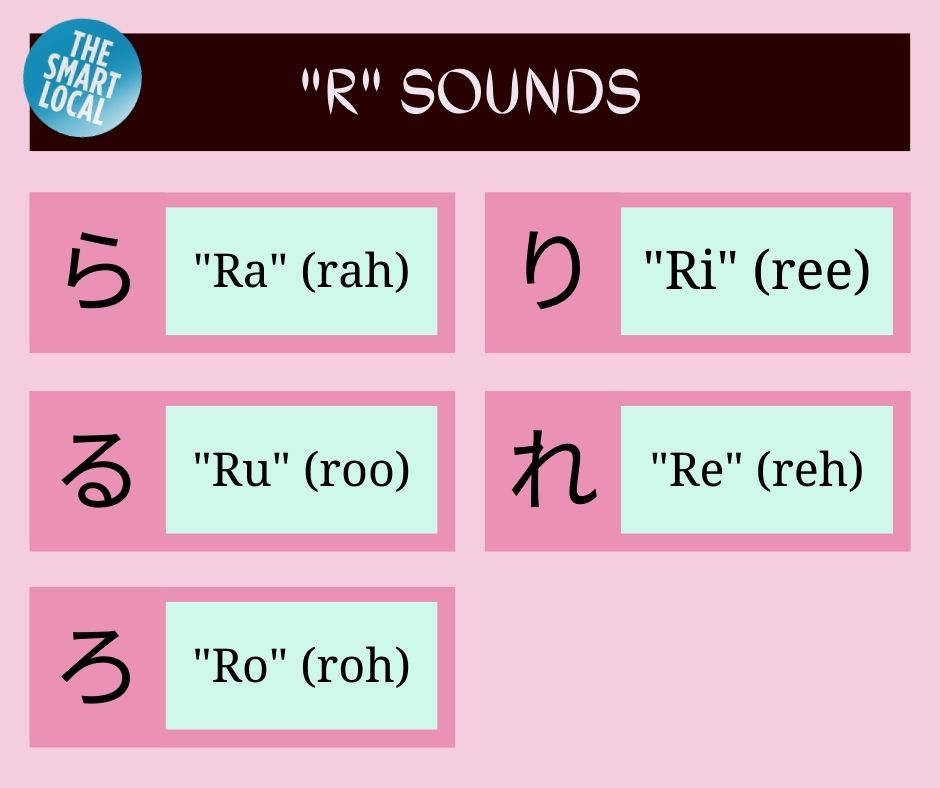 Image credit: Ng Yee Shyan
Image credit: Ng Yee Shyan
There are a total of 14 different consonant sounds in the Japanese language, many of which are similar to certain consonants in English. However, for those who require additional auditory assistance, videos that teach you the proper pronunciation are extremely helpful.
There are several consonant sounds that will be tricky for non-native speakers to pick up: ら り る れ ろ (ra ri ru re ro).
Although the romaji – a system of romanised spelling that is used to transliterate Japanese – for “らりるれろ” uses the English “r”, it is not pronounced the same way.
The way to correctly pronounce “らりるれろ” is perhaps somewhere in between the “l” and “r” sounds of the English language.
You can listen to the correct pronunciation for the Japanese “r” sound here:
Video credit: Learn Japanese with JapanesePod101.com
Another consonant to take note of would be “ん” (n), which is special because it can exist by itself without being paired with a vowel. The pronunciation of “ん” also changes depending on which word it is a part of.
“ん” is usually pronounced as “n” as intended; for example, “よん” (four) is read as “yon”. However, when pronouncing “せんぱい” (senpai; senior), the “ん” is pronounced more like the English “m”, thus, the word is pronounced as sempai instead.
 Image credit: Ng Yee Shyan
Image credit: Ng Yee Shyan
Lastly, when you are learning how to pronounce the “h” sounds – は ひ ふ へ ほ (ha hi hu he ho) – you may have a bit of trouble with “ふ” (hu), given that it is not pronounced the same way as the English “h”.
The pronunciation of “ふ” (hu) lies somewhere in between the English “f” and “h”. Do be careful not to pronounce “ふ” (hu) as “who” or “foo”!
Double consonants
In the Japanese language, double consonants are formed with the addition of a small “つ” (tsu). For example, in the word “がっこう” (gakkou; school), the small “つ” (tsu) represents the extra “k” in the romaji.
However, when spoken, the small “つ” (tsu) should not be pronounced. Instead, it’s replaced by a slight pause. To better understand the correct pronunciation of words that have a small “つ” (tsu), refer to this video:
Video credit: Learn Japanese with JapanesePod101.com
Pitch
Another thing that would set a beginner apart from a native Japanese speaker is the incorrect use of pitch while speaking. This may be slightly more advanced and nuanced, but it is still important to get it right.
There are a lot of Japanese words that have the same romaji and can only be differentiated by using different intonations.
 Image adapted from: Önder Örtel and Cody Hiscox
Image adapted from: Önder Örtel and Cody Hiscox
For example, “はし” (hashi) can mean chopsticks (箸) or bridge (橋) in Japanese, and in writing, they are distinguishable by their different kanji characters.
However, it is important to say it in the correct pitch in order to get the right idea across.
If you want to say hashi, as in chopsticks, try saying ha with a higher pitch and shi with a lower pitch. On the other hand, if you want to say hashi, as in bridge, you’d have to say ha with a lower pitch and shi with a higher pitch. Watch the video below for more clarity:
Video credit: Learn Japanese with JapanesePod101.com
5. Grammar and vocabulary
Picking up vocabulary and learning the correct grammar may seem like a handful as it can get confusing, but trusty Japanese textbooks such as Minna no Nihongo, Elementary Japanese, and Genki are a great help.
However, do take note that Genki is not catered towards self-learners, so you have to adjust accordingly should you choose to purchase it.
 Image credit: 3A Corporation
Image credit: 3A Corporation
If you are on a budget, we recommend purchasing the Minna no Nihongo Translation & Grammar Notes instead of buying the whole set.
Minna no Nihongo’s Translation & Grammar Notes include vocabulary lists and grammar notes that you can pick up week by week, which is helpful in providing a framework for your independent learning.
Another wallet-friendly alternative is Tae Kim’s Japanese Grammar Guide, though you will have to build your own vocabulary bank. Visit Japanese Pod 101 for their free vocabulary lists, which are sorted according to topics such as “transportation” or “nationalities”.
It’ll be useful to create your own vocabulary bank, be it on Anki or a simple Excel sheet, to slowly build up your personal database of Japanese words. Anytime you come across a new word, add it into your list and review them at the end of the week.
6. Dictionaries
 Image adapted from: Jisho.org
Image adapted from: Jisho.org
Google Translate may be the most convenient way to translate phrases or search up a word, but it is not the most reliable. A better alternative is Jisho.org, a Japanese-English dictionary that is not only accurate, but also user-friendly.
When searching for words, you can not only type hiragana, katakana, and kanji, but also romaji and English! If you are searching for a kanji that you do not know the pronunciation of, there is a handy handwriting function there to help you.
 Yomichan providing accurate translations for a NHK news article
Yomichan providing accurate translations for a NHK news article
Image adapted from: NHKニュース 速報
If you are too lazy to visit Jisho.org every time you come across a foreign word, consider installing Yomichan, a Google Chrome extension that shows you the meaning of the Japanese words when you press the shift key and hover your mouse over the words.
After installing Yomichan, proceed to Yomichan’s website to download the necessary e-dictionaries and import them over to the Chrome extension. Once you have imported the dictionaries, the extension should work like a pop-up dictionary or even a translator.
If you are already using Anki, that’s all the more reason to download Yomichan as its integration with Anki is perhaps its most useful feature, especially for self-learners. In short, you can instantly add new words that you come across to your Anki deck with just one click.
However, do not mindlessly add every single unknown word that you come across, or else your deck will be too overwhelming and inefficient. Instead, before adding a word, make sure that the word is common enough for daily use. Check out Yomichan’s website to learn how to integrate Yomichan with Anki.
7. Additional resources
The most important thing to do when trying to pick up a new language is to be consistent in using that language, be it in speech or in writing. Learning Japanese may require a lot of hard work and can become tedious over time, which is why it is important to consume different types of Japanese content.
The most entertaining way to immerse yourself in the language is to watch Japanese shows or listen to Japanese music that you actually like, as doing so will not only help with your pronunciation, but will also familiarise you with basic conversational vocabulary.
Certain shows on Netflix offer Japanese subtitles, and reading them while you watch your show is a useful way to improve your reading ability.
 Image credit: @JapaneseQuest
Image credit: @JapaneseQuest
Alternatively, you can download Language Reactor, a Google Chrome extension that displays both English and Japanese subtitles at the same time. Similar to Yomichan, you can mouse over the subtitles to access the meaning of the words.
You can also practise your reading skills by visiting NHK’s NEWS WEB EASY, a website that uploads 4 beginner-friendly news articles a day. The articles include furigana – small hiragana characters above the kanji – and Japanese audio to aid your reading process.

Image adapted from: Tadoku
Should news be too dry for you, perhaps Japanese children’s storybooks will be a more interesting alternative. You can read storybooks for free on Tadoku, where the books are categorised according to their difficulty level.

Image credit: TVアニメ『SPY×FAMILY』
And if you want to learn Japanese on the go, try listening to Japanese Spotify podcasts. Beginners can follow Learn Japanese with Masa sensei, while those who are more advanced can opt for lighthearted anime podcasts such as SPYxFAMILY Operation podcast.
There is also a variety of Japanese content available on YouTube, such as the adorable and easily understandable videos produced by Learn Japanese with Tanaka san, and livestreams of popular Japanese virtual YouTubers. You can consume your daily entertainment while exposing yourself to Japanese, thus killing two birds with one stone.
Lastly, there are also many games that teach you simple Japanese, and these are available both on mobile and PC.
Dummies guide to learning Japanese on your own
How difficult can it be to learn Japanese on your own when you have all these resources at your disposal? Just kidding, we know that Japanese is difficult to learn, but we hope that this guide will help make your journey easier.
Also check out:
- Common speech habits in anime to avoid
- Japanese slang to know
- Japanese internet slang
- Useful Japanese tips
- Basic Japanese phrases
Cover image adapted from: Hiroshi Tsubono, WaniKani, Tadoku, and Niketh Vellanki
